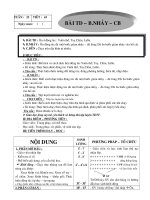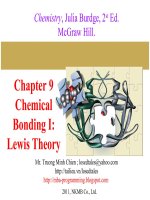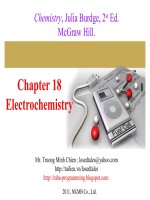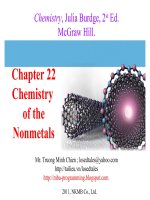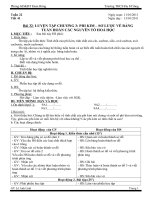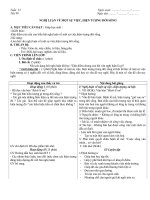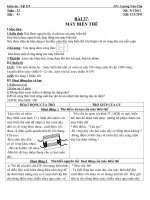Gián án Chapter 22 Chemistry of the Nonmetals
Bạn đang xem bản rút gọn của tài liệu. Xem và tải ngay bản đầy đủ của tài liệu tại đây (5.89 MB, 70 trang )
Chapter 22
Chemistry
of the
Nonmetals
2011, NKMB Co., Ltd.
Chemistry, Julia Burdge, 2
st
Ed.
McGraw Hill.
Mr. Truong Minh Chien ;
/>
2
Nanotubes
•
nanotubes – long, thin, hollow cylinders of atoms
•
carbon nanotube = sp
2
C in fused hexagonal rings
electrical conductors
•
boron-nitride nanotubes = rings of alternating B and N
atoms
isoelectronic with C
similar size to C
average electronegativity of B & N about the same as C
electrical insulators
Chemistry, Julia Burdge, 2
nd
e., McGraw Hill.
3
Insulated Nanowire
Chemistry, Julia Burdge, 2
nd
e., McGraw Hill.
4
Properties of BN and C
Chemistry, Julia Burdge, 2
nd
e., McGraw Hill.
5
Main Group Nonmetals
Chemistry, Julia Burdge, 2
nd
e., McGraw Hill.
6
Atomic Radius and Bonding
•
atomic radius decreases across the period
•
electronegativity, ionization energy increase across the
period
•
nonmetals on right of p block form anions in ionic
compounds
often reduced in chemical reactions
making them oxidizing agents
•
nonmetals on left of p block can form cations and
electron-deficient species in covalent bonding
•
nonmetals near the center of the p block tend to use
covalent bonding to complete their octets
•
bonding tendency changes across the period for
nonmetals from cation and covalent; to just covalent; to
anion and covalent
Chemistry, Julia Burdge, 2
nd
e., McGraw Hill.
7
Silicates
•
the most abundant elements of the Earth’s crust
are O and Si
•
silicates are covalent atomic solids of Si and O
and minor amounts of other elements
found in rocks, soils, and clays
silicates have variable structures – leading to the
variety of properties found in rocks, clays, and soils
Chemistry, Julia Burdge, 2
nd
e., McGraw Hill.
8
Bonding in Silicates
•
each Si forms a single covalent bond to 4 O
sp
3
hybridization
tetrahedral shape
Si-O bond length is too long to form Si=O
•
to complete its octet, each O forms a single
covalent bond to another Si
•
the result is a covalent network solid
Chemistry, Julia Burdge, 2
nd
e., McGraw Hill.
9
Quartz
•
a 3-dimensional covalent network
of SiO
4
tetrahedrons
•
generally called silica
•
formula unit is SiO
2
•
when heated above 1500°C and
cooled quickly, get amorphous
silica which we call glass
Chemistry, Julia Burdge, 2
nd
e., McGraw Hill.
10
Aluminosilicates
•
Al substitutes for Si in some of the lattice sites
•
SiO
2
becomes AlO
2
−
•
the negative charge is countered by the inclusion
of a cation
Albite = ¼ of Si replaced by Al; Na(AlO
2
)(SiO
2
)
3
Anorthite = ½ of Si replaced by Al; Ca(AlO
2
)
2
(SiO
2
)
2
Chemistry, Julia Burdge, 2
nd
e., McGraw Hill.
11
Silicates Made of Individual Units
•
O of SiO
4
picks up electrons from metal to form SiO
4
4−
•
if the SiO
4
4−
are individual units neutralized by cations, it
forms an orthosilicate
willemite = Zn
2
SiO
4
•
when two SiO
4
units share an O, they form structures
called pyrosilicates with the anion formula Si
2
O
7
6−
hardystonite =Ca
2
ZnSi
2
O
7
Chemistry, Julia Burdge, 2
nd
e., McGraw Hill.
12
Single Chain Silicates
•
if the SiO
4
4−
units link as long
chains with shared O, the
structure is called a pyroxene
•
formula unit SiO
3
2-
•
chains held together by ionic
bonding to metal cations
between the chains
diopside = CaMg(SiO
3
)
2
where Ca
and Mg occupy lattice points
between the chains
Chemistry, Julia Burdge, 2
nd
e., McGraw Hill.
13
Double Chain Silicates
•
some silicates have 2
chains bonded together
at ½ the tetrahedra –
these are called
amphiboles
•
often results in fibrous
minerals
asbestos
tremolite asbestos =
Ca
2
(OH)
2
Mg
5
(Si
4
O
11
)
2
Chemistry, Julia Burdge, 2
nd
e., McGraw Hill.
14
Sheet Silicates
•
when 3 O of each
tetrahedron are shared,
the result is a sheet
structure called a
phyllosilicate
•
formula unit = Si
2
O
5
2−
•
sheets are ionically
bonded to metal cations
that lie between the
sheets
•
talc and mica
Chemistry, Julia Burdge, 2
nd
e., McGraw Hill.
Tro, Chemistry: A Molecular Approach 15
Mica: a Phyllosilicate
Tro, Chemistry: A Molecular Approach 16
Silicate Structures
Tro, Chemistry: A Molecular Approach 17
Boron
•
metalloid
•
at least 5 allotropes, whose structures are
icosahedrons
each allotrope connects the icosahedra in
different ways
• less than 0.001% in Earth’s crust, but
found concentrated in certain areas
almost always found in compounds with O
borax = Na
2
[B
4
O
5
(OH)
4
]⋅8H
2
O
kernite = Na
2
[B
4
O
5
(OH)
4
]⋅3H
2
O
colemanite = Ca
2
B
6
O
11
⋅5H
2
O
•
used in glass manufacturing – borosilicate
glass = Pyrex
•
used in control rods of nuclear reactors
Tro, Chemistry: A Molecular Approach 18
Boron Trihalides
•
BX
3
•
sp
2
B
trigonal planar, 120° bond angles
forms single bonds that are shorter and stronger than
sp
3
C
some overlap of empty p on B with full p on halogen
•
strong Lewis Acids
Tro, Chemistry: A Molecular Approach 19
Boron-Oxygen Compounds
•
form structures with trigonal
BO
3
units
•
in B
2
O
3
, six units are linked
in a flat hexagonal B
6
O
6
ring
melts at 450°C
melt dissolves many metal
oxides and silicon oxides to form
glasses of different compositions
Tro, Chemistry: A Molecular Approach 20
Boranes
closo-Boranes
•
compounds of B and H
•
used as reagent in hydrogenation of C=C
•
closo-Boranes have formula B
n
H
n
2−
and form
closed polyhedra with a BH unit at each vertex
Tro, Chemistry: A Molecular Approach 21
Boranes
nido-Boranes and arachno-Boranes
•
nido-Boranes have formula B
n
H
n+4
consisting of
cage B missing one corner
•
arachno-Boranes have formula B
n
H
n+6
consisting
of cage B missing two or three corners
Tro, Chemistry: A Molecular Approach 22
Carbon
•
exhibits the most versatile bonding of all the
elements
•
diamond structure consists of tetrahedral sp
3
carbons in a 3-dimensional array
•
graphite structures consist of trigonal planar sp
2
carbons in a 2-dimensional array
sheets attracted by weak dispersion forces
•
fullerenes consist of 5 and 6 member carbon
rings fused into icosahedral spheres of at least
60 C
23
Crystalline Allotropes of Carbon
Diamond Graphite Buckminster-
fullerene, C
60
Color clear-blue black black
Density, g/cm
3
3.53 2.25 1.65
Hardness, Mohs Scale 10 0.5
Electrical Conductivity, (µΩ•cm)
-1
~10
-11
7.3 x 10
-4
~10
-14
Thermal Conductivity, W/cm•K 23
20 ()
Melting Point, °C
~3700 ~3800 800 sublimes
Heat of Formation (kcal/mol) 0.4 0.0 9.08
Refractive Index 2.42 ─ 2.2 (600 nm)
Source Kimberlite
(S. Africa)
Pegmatite
(Sri Lanka)
Shungite
(Russia)
Tro, Chemistry: A Molecular Approach 24
Allotropes of Carbon - Diamond
Inert to Common Acids
Inert to Common Bases
Negative Electron Affinity
Transparent
Hardest
Best Thermal Conductor
Least Compressible
Stiffest
Tro, Chemistry: A Molecular Approach 25
Allotropes of Carbon - Graphite
Soft and Greasy Feeling
Solid Lubricant
Pencil “Lead”
Conducts Electricity
Reacts with Acids and
Oxidizing Agents


